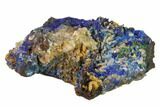This Specimen has been sold.
3.9" Druzy Azurite Crystals on Dolomite - Morocco
This 3.9" wide specimen features a druze of azurite that formed over dolomite crystals, collected from morocco. There are some small spots of malachite peppered throughout the specimen.
Azurite and malachite are known to form in union with each other since their chemical makeup is very similar. In fact, the presence of more or less water in the location of formation is enough to determine whether an abundance of malachite over azurite, or vise-versa, will accumulate.
These minerals tend to be found near copper deposits, which accounts for the vibrant colors the minerals display. This association of azurite and malachite on copper-rich, iron oxide matrix was found near M'Cissi, Alnif, Tinghir Province, Souss-Massa-Draâ Region, Morocco.
These minerals tend to be found near copper deposits, which accounts for the vibrant colors the minerals display. This association of azurite and malachite on copper-rich, iron oxide matrix was found near M'Cissi, Alnif, Tinghir Province, Souss-Massa-Draâ Region, Morocco.
About Azurite
Azurite is a copper carbonate hydroxide mineral best known for its beautiful and vibrant blue appearance. Azurite typically forms in nodular formations with other colorful, copper-rich minerals. It is a secondary mineral that precipitated in pores, crevices, and caverns from water with high concentrations of carbon dioxide.
Azurite and malachite are known to form in union with each other since their chemical makeup is very similar. In fact, the presence of more or less water in the location of formation is enough to determine whether an abundance of malachite over azurite, or vise-versa, will accumulate.
Azurite is a copper carbonate hydroxide mineral best known for its beautiful and vibrant blue appearance. Azurite typically forms in nodular formations with other colorful, copper-rich minerals. It is a secondary mineral that precipitated in pores, crevices, and caverns from water with high concentrations of carbon dioxide.
Azurite and malachite are known to form in union with each other since their chemical makeup is very similar. In fact, the presence of more or less water in the location of formation is enough to determine whether an abundance of malachite over azurite, or vise-versa, will accumulate.
About Malachite
Malachite is an intense green copper-based mineral that can be found in a wide variety of forms. Malachite can grow in botryoidal masses, stalactitic formations, and reniform formations, typically as a tight cluster of fanning fibrous needles that make up a seemingly solid mass. As layers continue to stack during formation, banded patterns can sometimes begin to take shape, explaining the rings in all shades of green seen on most polished malachite specimens.
Malachite results from the weathering of other copper ores, and is very often found associated with other copper-based minerals such as azurite and chrysocolla. It can be found in copper deposits around the world, but the Democratic Republic of the Congo is the primary source for polished malachite and mineral specimens.
Malachite has been prized since ancient times, first as a utilitarian copper ore, then as an ornamental stone. Due to its value as a decorative stone, it is rarely mined as a copper ore anymore.
Malachite is an intense green copper-based mineral that can be found in a wide variety of forms. Malachite can grow in botryoidal masses, stalactitic formations, and reniform formations, typically as a tight cluster of fanning fibrous needles that make up a seemingly solid mass. As layers continue to stack during formation, banded patterns can sometimes begin to take shape, explaining the rings in all shades of green seen on most polished malachite specimens.
Malachite results from the weathering of other copper ores, and is very often found associated with other copper-based minerals such as azurite and chrysocolla. It can be found in copper deposits around the world, but the Democratic Republic of the Congo is the primary source for polished malachite and mineral specimens.
Malachite has been prized since ancient times, first as a utilitarian copper ore, then as an ornamental stone. Due to its value as a decorative stone, it is rarely mined as a copper ore anymore.
Dolomite is an anhydrous carbonate mineral composed of calcium magnesium carbonate (CaMg(CO3)2).
The mineral dolomite crystallizes in the trigonal-rhombohedral system. It forms white, tan, gray, or pink crystals. Dolomite is a double carbonate, having an alternating structural arrangement of calcium and magnesium ions. It does not rapidly dissolve in dilute hydrochloric acid as calcite does. Crystal twinning is common.
Dolomite was first described by Carl Linnaeus in 1768, and in 1791 it was described as a rock by the French naturalist and geologist Déodat Gratet de Dolomieu. He first recognized the material in buildings of the old city of Rome, and later as samples collected in the mountains known as the Dolomite Alps of northern Italy.
The mineral dolomite crystallizes in the trigonal-rhombohedral system. It forms white, tan, gray, or pink crystals. Dolomite is a double carbonate, having an alternating structural arrangement of calcium and magnesium ions. It does not rapidly dissolve in dilute hydrochloric acid as calcite does. Crystal twinning is common.
Dolomite was first described by Carl Linnaeus in 1768, and in 1791 it was described as a rock by the French naturalist and geologist Déodat Gratet de Dolomieu. He first recognized the material in buildings of the old city of Rome, and later as samples collected in the mountains known as the Dolomite Alps of northern Italy.
SPECIES
Azurite, Dolomite & Malachite
LOCATION
Morocco
SIZE
3.9 x 2.8"
CATEGORY
ITEM
#137428
 Reviews
Reviews














